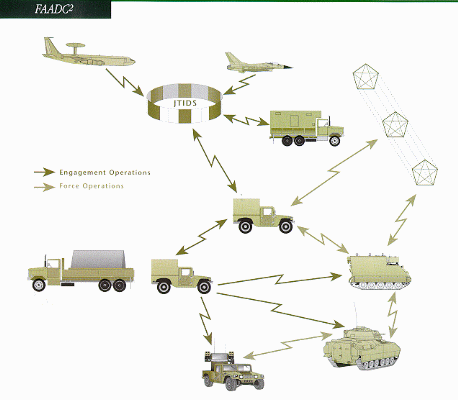



The FAADC3I system is the central element of forward air defense, and is designed to counter the low altitude air threat over and beyond a divisionís area operation. FAADC3I is the Air Defense system supporting Force XXI Battlefield Command, Brigade and Below (FBCB2) while satisfying the need for seamless communications, vertically and horizontally. FAADC3I provides timely target data to SHORAD weapons, preventing the potential for fratricide, and assisting commanders to see the battlefield from anywhere on the battlefield. FAADC3I is the glue that binds all the pieces of the divisional short-range air defense (SHORAD) system together.
FAADC3I provides the battle captains the tools necessary to pierce the fog of battle, and the ability to place the correct size force, at the correct location, at the critical time needed to defeat enemy air threats. To do this requires both engagement operations (EO) and force operations (FO) capabilities. Engagement Operations (EO) take sensing data from organic HIMAD and joint sensors, passes cueing information to SHORAD weapons, and places steel on target while protecting friendly forces from fratricide. Force Operations (FO) manages scarce SHORAD assets by knowing the status, location, and posture of all elements so they can be properly supported and sustained.
It provides the means for collecting, storing, processing, displaying and disseminating the information necessary for the weapon systems to perform their mission of defending ground assets from air attack. The system provides an automated, timely picture of the air defense battle throughout the division and forward commander's area of influence. Integrating sensor inputs from various sources, FAADC3I provides early warning, targeting, and control information to FAAD and supported units. An area of interest air picture is developed and air tracks are identified using automated and manual means. Threat tracks cause alerts, with fire units automatically cued to the targets.
It is designed to accomplish and enhance the major mission functions of alerting air defense artillery and protected units, cueing FAAD fire units operators, exchanging air battle management information weapon control, exchanging and processing air defense command information, and automated interface between FAAD and other air defense elements and the Army Tactical Command and Control System (ATCCS). The system uses CHS processors and operating systems, with data communications provided by the Army Data Distribution System (ADDS), SINCGARS, or dedicated digital radio links.
The FAADC3I system supports air defense operations at both the tactical and operational levels of war. The FAADC3I system supports the short range air defense (SHORAD) mission through its automated air defense Engagement Operations (EO) and Force Operations (FO) capabilities. The EO software performs two functions, air track and command and control coordination. FO provides automated assistance in defense planning, routine management duties and communications. The FO software is the Commanders Real-time Tactical Display. FAADC3I receives air track information from both internal and external sources. The Sentinel Radar in heavy units and the Light and Special Division Interim Sensor (LSDIS) in light units provide internal track data. The Sentinel radar is a three dimensional phased array radar with an integrated Identification Friend or Foe (IFF). The Sentinel radar automatically detects, tracks, classifies, identifies and reports targets from unmanned aerial vehicles (UAVs), cruise missiles and helicopters to fixed wing aircraft. This capability provides the commander with third dimension situational awareness for his immediate area of operations (AO). FAADC3I also receives track data from external sources, and it is this capability that contributes to the deep fight. FAADC2I receives Air Force Airborne Warning and Control System (AWACS) data via a Tactical Digital Interface Link - Joint (TADIL-J) link and data from High to Medium Altitude Air Defense (HIMAD) Systems such as PATRIOT and MEADS via a TADIL-B link. These external sources provide the commander with a correlated air picture that extends throughout his battlespace.The initial development effort of FAADC2I is concentrating on engagement operations, which are real-time actions supporting aircraft engagement. The system will begin encompassing more force operations functionality (e.g., all unit plans, support, and day-to-day operations) as the program matures.
At the corps level, FAADC2I will be integrated with PATRIOT, HAWK, and future Corps SAM and their associated C2 systems into the comprehensive Air and Missile Defense (AMD) system. Within AMD, essential C3I operational functions will be distributed among Air Defense Tactical Operations Centers (ADTOCs), sensor nodes, and fire units throughout the depth of the battlefield, providing the capability to acquire, process and distribute information necessary for the planning and coordination of AMD operations. The ADTOC will serve as the AMD link to ABCS and joint/allied C3I systems. It will process and distribute the information required to direct AMD forces and synchronize the their actions with the maneuver commander’s concept of operations.
The objective AMD system will be achieved through an evolutionary process.
- Block I: the current FAADC2I and the prototype Air Defense Brigade TOC.
- Block II: improvements to the PATRIOT Battalion TOC and the battalion-level Improved C3I (IC3I) capability of FAAD. It will also provide a battalion/battery- level IC3I capability for the Theater High Altitude Air Defense System (THAAD).
- Block III: the objective system and reflects the fielding of the ADTOC capability and the required vertical and horizontal interfaces to ABCS.
- Block IV: reflects P3I.
